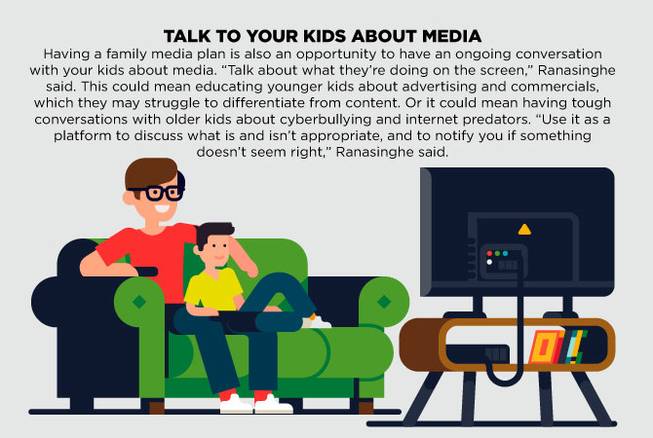
Tuesday, Sept. 5, 2017 | 2 a.m.
The American Academy of Pediatrics (AAP) recommends that parents monitor the amount of time kids spend looking at screens, but the ubiquitous nature of our personal devices can make this a difficult task. Because of this far-reaching influence, the best way to address your child’s screen usage may also be to address your own.
“Limit your own screen time. Kids model their parents—be that good example,” said Ruchika Ranasinghe, MD, a pediatrician at Sunrise Children’s Hospital.
Creating a family media plan and ensuring that everyone is following it can allow parents to successfully monitor their children’s — and their own — screen time.
AAP age recommendations
18 months and younger: No screens
“Introducing the screen before 18 months of age can contribute to language delays,” Ranasinghe said. However, she notes that video chatting to keep in touch with family members can be started earlier if desired.
2 through 5 years old: One hour
By the time a child is 2, they can begin watching TV and even playing games, but the type of exposure is critical. “Programs should be of high educational value, such as “Sesame Workshop. Further, co-viewing is important to help the child understand what they’re watching,” Ranasinghe said. While co-viewing, maintain an open dialogue and discuss the content with your child.
6 through 18 years old: Two hours
While the AAP recommends limiting screen time to two hours for school-age children, the nature of the content should be considered as kids get older. For instance, many children, adolescents and teens will need to access the internet for homework and class assignments. The two-hour limit can be designated purely for recreational use as long as it doesn’t interfere with school work, social interaction, physical activity and/or sleep.
Creating a family media plan
Instituting a family media plan allows parents to monitor their child’s screen time and can help children develop long-term, healthy attitudes toward media consumption.
To create a family media plan, simply list the rules and guidelines that everyone in the home is expected to follow. It’s important that the entire family adhere to the plan because doing so gives children the opportunity to learn from example and sets a standard for what reasonable media consumption should look like.
When outlining the plan, be considerate to your family’s general lifestyle as well as the independent needs of each member. The plan should be helpful and clear, but not overly restrictive.
Having media-free times and/or zones is a great way to start implementing restrictions. “For instance, no media usage during mealtimes, all devices must be turned off one hour before bedtime, no screens in the car, no TV in the bedrooms, etc.,” Ranasinghe said.
Other potential guidelines for your family media plan
• Any new app, game, program, movie, etc. needs to be previewed by a parent before the child can engage with it.
• Devices can only be used while a parent is present to supervise.
• Parental controls will be used to filter appropriate content.
• Only a select list of programs, channels and websites are allowed to be accessed by the child.
• Parents need to have knowledge of and login information for any relevant account (including social media).
• Devices can only be used once homework, chores and other responsibilities are completed.
• For every 30 minutes of TV/internet, the child has to spend 30 minutes reading a book/coloring/etc. Ranasinghe notes that unplugged and unstructured playtime is extremely important. Customize the plan so that it works for your family and varies depending on age and experience level.
Talk to your kids about media
Having a family media plan is also an opportunity to have an ongoing conversation with your kids about media. “Talk about what they’re doing on the screen,” Ranasinghe said.
This could mean educating younger kids about advertising and commercials, which they may struggle to differentiate from content. Or it could mean having tough conversations with older kids about cyberbullying and internet predators.
“Use it as a platform to discuss what is and isn’t appropriate, and to notify you if something doesn’t seem right,” Ranasinghe said.

Join the Discussion:
Check this out for a full explanation of our conversion to the LiveFyre commenting system and instructions on how to sign up for an account.
Full comments policy